What does the partial ban on face coverings entail?
On 1 August 2019 a ban was introduced on face coverings on public transport or in and around government, healthcare or educational buildings. This means that in these places you may no longer wear clothing that makes your face unidentifiable, such as a full-face motorcycle helmet or burka.
This is laid down in the Face Coverings (Partial Ban) Act (Dutch). This Act is sometimes referred to as the ‘burka ban’ or ‘nikab ban’. The Act is intended to prevent face coverings being worn in places where it is necessary to recognise each other and see each other’s faces.
Locations where face coverings are banned
The ban on wearing face coverings applies in and around the buildings of healthcare institutions, educational institutions and government organisations and on public transport. ‘Face covering’ refers to any item of clothing that prevents your face being identified. This includes balaclavas, burkas, nikabs, full-face motorcycle helmets and masks. The ban does not apply to headscarves, face paint and hats. A member of staff may inform you that a ban is in place and ask you to either leave the premises or remove your face covering. If you refuse to comply, the staff member can call the police, who may fine you.
